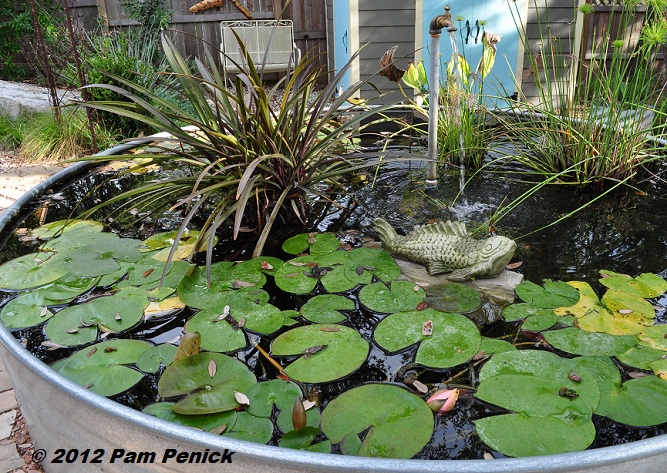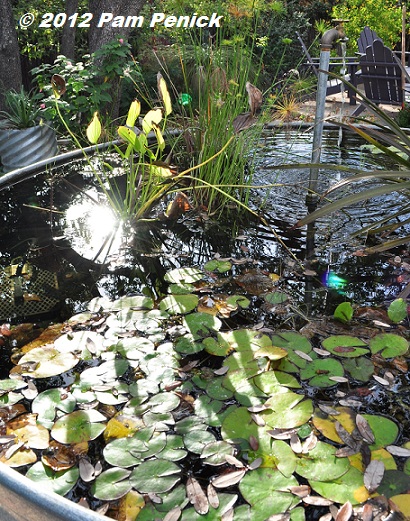Winterizing a stock tank pond
“How to make a container pond in a stock tank” is consistently one of my most-viewed posts, and many readers have written to tell me they’ve made their own ponds by following my instructions. Recently two people asked me how to winterize their ponds, so I decided to explain how in part 2 of what will be a 3-part series. This spring I’ll end the series by showing how to divide pond plants and prep the pond for summer growth.
Winterizing a stock-tank pond is actually quite simple in Austin’s mild-winter climate. It involves these six steps (3 of which are really inactions):
Scoop fallen leaves
Use a net to scoop fallen leaves off the surface of your pond several times a week to keep them from sinking and decomposing in the bottom of your tank. My pond is situated near live oaks, which don’t lose their leaves until March, so my biggest leaf clean-up occurs then.
Don’t divide pond plants yet
Your water lilies and other pond plants likely grew vigorously over the summer, and you may have noticed that some of them are literally bursting out of their pots. It’s amazing what these plants are capable of. By fall, my water lilies are no longer blooming as much, and their leaves may be mottled and a bit mushy, but at the bottom of the pond they are vigorous monsters, with roots creeping out of their pots and possibly supporting a fully formed baby plant. Marginal plants that live at the top of the pond, like dwarf papyrus, may have reproduced as well, with new plants rooting from fallen stems floating in the water.
It may be tempting to divide and repot your pond plants now, since they are clearly trying so hard to reproduce, but don’t. The first hard freeze will likely turn your lilies into mush, causing them to die back to the roots. That’s fine. Just pull out any mushy stems and rotten leaf pads; they should easily come loose when you lightly tug them. In our typical mild winters, your lilies may retain leaves and even bloom occasionally through the winter. Enjoy!
Drop cold-tender plants to the bottom of the pond during hard freezes
Hard freezes won’t hurt hardy water lilies (tropical lilies may need to be overwintered indoors). But they might kill your cold-tender marginal plants, which live at the top of the pond. I’ve lost dwarf papyrus and pond crinum in hard freezes, for example. So now, when a hard freeze is predicted, I drop the pots to the bottom of the pond until the air temperature is above freezing again. In central Texas, hard freezes rarely last longer than a few hours, so I’ll pull the plants back up to their perches in the afternoon. But if we get a real doozy of a cold snap, I’ll leave them at the bottom for two or three days, and they’ll be fine—a little mushy, perhaps, but alive.
Turn off your bubbler pump or fountain during hard freezes
If you have a pump in your pond, turn it off if a hard freeze is predicted unless it’s powerful enough to keep the water from freezing. I don’t take a chance, and simply unplug mine during freezing weather. The pump itself sits a foot under the surface, so it’s not going to be damaged even if the surface of the water ices over. If your pump sits right at the surface, then drop it to the bottom of the pond or remove it so that water is not able to freeze inside it.
Stop feeding fish
I rarely feed my goldfish and gambusia fish, and they survive just fine on algae, mosquito larvae (they keep the tank clean of these pests), and my underwater plants. But if you regularly feed your fish, stop when the weather turns cool. The fish will go into a semi-dormant state over the winter, and they won’t be able to digest food properly until the water warms up again. Just let them be.
Stop fertilizing your plants
Most pond plants stop growing in cooler weather, so stop using fertilizer tablets now. From late October to early April, don’t fertilize. Resume feeding after you’ve divided your plants in spring (which I’ll cover in detail next spring).
Remember: Prepping your stock-tank pond for winter may require more extensive measures if you live in a colder climate than I do—including, perhaps, overwintering your fish indoors, unplugging your pump, and even emptying your pond for the season. (See comment #8 below from a reader in central Ohio; she offers her winterization tips.) The winterization that I do is sufficient for my 2-foot deep pond in my zone 8b garden.
This is part 2 of a 3-part pond series:
Part 1 — How to make a container pond in a stock tank
Part 2 — Winterizing a stock tank pond
Part 3 — How to spring clean your stock tank container pond
All material © 2006-2012 by Pam Penick for Digging. Unauthorized reproduction prohibited.




The post couldn’t come at a more perfect time as I contemplate the arrival of a stock tank in my garden and learn all that has to be done. Heading over to to look at your original post.
I hope the information is useful, Jenny, as you set up your pond. I really find it very easy to maintain. I think yours will be even easier because you won’t have shade trees hanging over yours. —Pam
Perfect! Just what I needed to know. I would not have thought to sink the dwarf papyrus and other marginals to protect them from a freeze. Frankly, I feel relieved to not need to divide plants at this busy time of the year. I’ll just save that for the spring when it will seem more exciting to go sink an arm up to the shoulder into cool water. 🙂 -v
Yes, better to put off mucking around in chilly water for later! —Pam
I winterized for the first time this year. Typically I’ve lost all my .13 cent goldfish to birds, but this year I have several. I took all the tropical plants for dormant storage in the garage (we’re 7b) and have a net of shade fabric secured with computer hard drive magnets over the top of the tank to keep falling leaves out. I also bought a stock tank water heater to keep the water from icing over which can kill fish by trapping gasses that are normally released through the surface. The pump got pulled out as well.
Jeanne, thank you for sharing your winterization tips for your colder winter climate in Idaho. —Pam
You rock Pam- when I get that pond I have detailed instructions for everything A-Z! Thank you for sharing all of your tips and instructions. Hope y’all had a lovely Thanksgiving. 🙂 thank you for all you share.
You’re very welcome, Heather! I’m happy to share what I’ve learned about keeping a stock-tank pond. —Pam
Very timely – I was wondering whether my goldfish would make it through the winter. Now I know to quit feeding them! I love helpful hints that let me do less . . .
Less is definitely more sometimes. 😉 —Pam
It’s our first winter trying to keep goldfish alive in our new above-ground pond. My husband has plexiglass sheets over the top, but with air exchange on the sides. He installed a de-icer/heater to prevent the water from freezing solid all the way through. We’re in Wisconsin, so it’s a much harsher climate. It will be interesting to see if his techniques work. The four goldfish are still alive after weeks of hard freezes. But the true test will be the subzero weather in January and February. I’ll keep you posted!
Fingers crossed for your goldfish, PP. They are pretty tough fish! —Pam
@PlantPostings, I would be interested to hear how your fish turned out. I live in Arkansas (not as cold winters as Wisconsin, I guess) but I don’t want to get fish for a 2′ deep/8′ wide circular stock pond only to have them die.
Alex, I think that goldfish are cold-hardy and resilient, essentially going dormant in cold weather. So long as your pond does not freeze solid, they will likely just semi-hibernate at the bottom of the pond. However, they’d still need oxygen, so you may need to use a heater to keep an air hole open during freezing weather. Or (and I realize this may sound harsh) just buy new fish in the spring. They are very inexpensive at pet stores. Of course, I’m not talking koi—they are an investment. —Pam
This was sent from a reader in central Ohio: